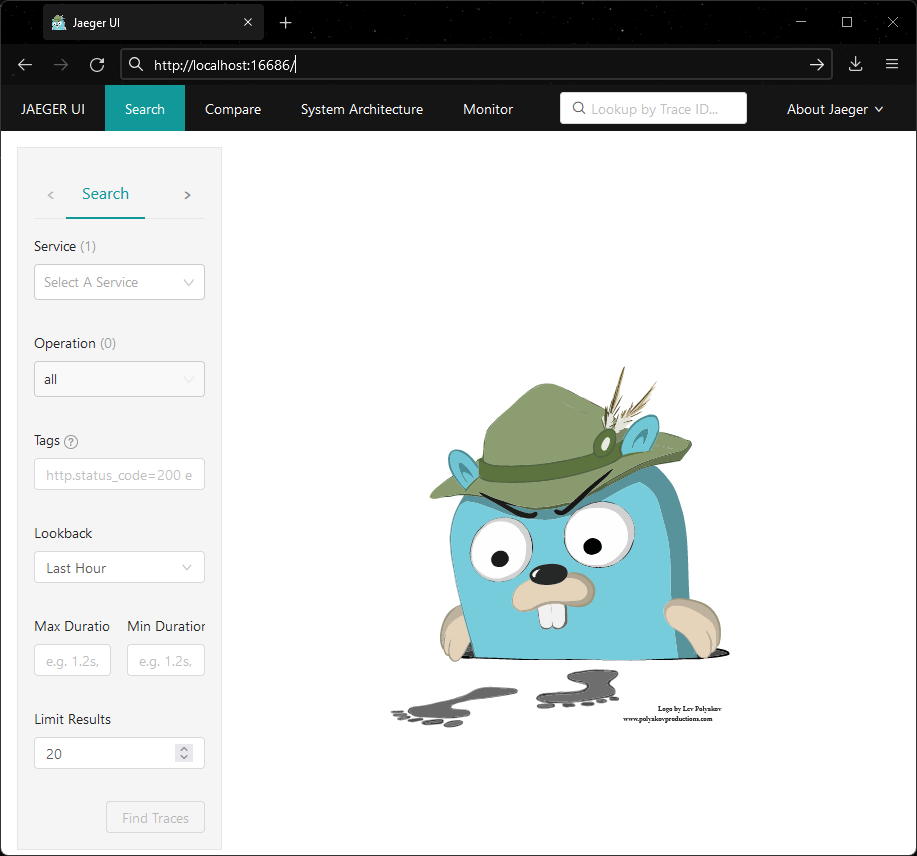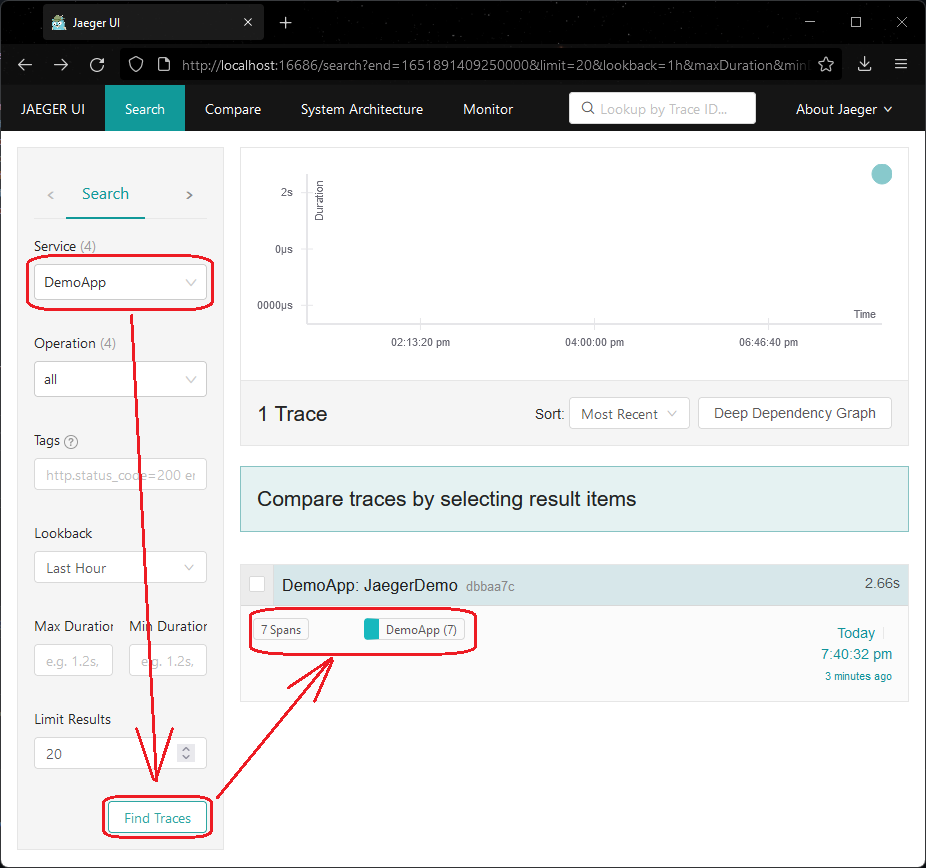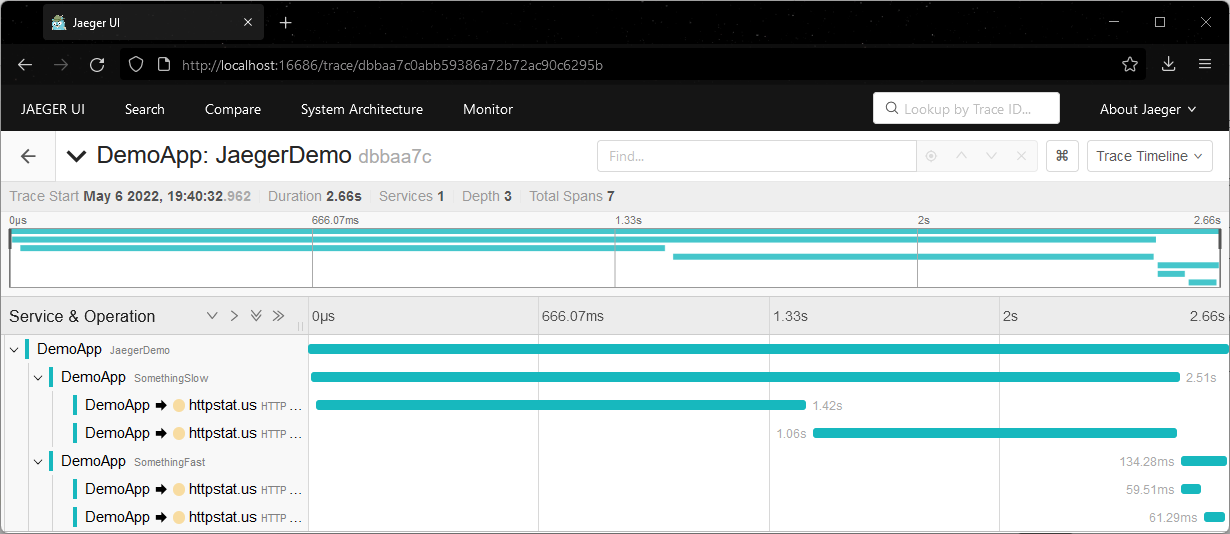# Getting Started with Jaeger
Table of Contents
* [Export traces from the application](#export-traces-from-the-application)
* [Check results in the console](#check-results-in-the-console)
* [Collect and visualize traces using Jaeger](#collect-and-visualize-traces-using-jaeger)
* [Final cleanup](#final-cleanup)
* [Learn more](#learn-more)
## Export traces from the application
It is highly recommended to go over the [getting started in 5 minutes - ASP.NET
Core Application](../getting-started-aspnetcore/README.md) guide or the [getting
started in 5 minutes - Console
Application](../getting-started-console/README.md) guide before following along
this document.
Create a new console application and run it:
```sh
dotnet new console --output getting-started-jaeger
cd getting-started-jaeger
dotnet run
```
Add reference to [Console
Exporter](../../../src/OpenTelemetry.Exporter.Console/README.md), [OTLP
Exporter](../../../src/OpenTelemetry.Exporter.OpenTelemetryProtocol/README.md) and
[HttpClient Instrumentation](https://github.com/open-telemetry/opentelemetry-dotnet-contrib/tree/main/src/OpenTelemetry.Instrumentation.Http/README.md):
```sh
dotnet add package OpenTelemetry.Exporter.Console
dotnet add package OpenTelemetry.Exporter.OpenTelemetryProtocol
dotnet add package OpenTelemetry.Instrumentation.Http
```
Now copy the code from [Program.cs](./Program.cs).
### Check results in the console
Run the application again and we should see the trace output from the console:
```text
> dotnet run
Activity.TraceId: 693f1d15634bfe6ba3254d6f9d20df27
Activity.SpanId: 429cc5a90a753fb3
Activity.TraceFlags: Recorded
Activity.ParentSpanId: 0d64498b736c9a11
Activity.ActivitySourceName: System.Net.Http
Activity.DisplayName: GET
Activity.Kind: Client
Activity.StartTime: 2024-07-04T13:18:12.2408786Z
Activity.Duration: 00:00:02.1028562
Activity.Tags:
http.request.method: GET
server.address: httpstat.us
server.port: 443
url.full: https://httpstat.us/200?sleep=Redacted
network.protocol.version: 1.1
http.response.status_code: 200
Resource associated with Activity:
service.name: DemoApp
service.version: 1.0.0
service.instance.id: 03ccafab-e9a7-440a-a9cd-9a0163e0d06c
telemetry.sdk.name: opentelemetry
telemetry.sdk.language: dotnet
telemetry.sdk.version: 1.9.0
...
```
Note that we have configured two exporters in the code:
```csharp
using var tracerProvider = Sdk.CreateTracerProviderBuilder()
...
.AddConsoleExporter()
.AddOtlpExporter()
.Build();
```
When we ran the application, the `ConsoleExporter` was printing the traces on
console, and the `OtlpExporter` was attempting to send the traces to Jaeger
Agent via the default endpoint `http://localhost:4317`.
Since we didn't have Jaeger running, the traces received by `OtlpExporter`
were simply dropped on the floor. In the next step, we are going to learn about
how to use Jaeger to collect and visualize the traces.
```mermaid
graph LR
subgraph SDK
TracerProvider
SimpleExportProcessor["SimpleExportProcessor < Activity >"]
BatchExportProcessor["BatchExportProcessor < Activity >"]
ConsoleExporter
OtlpExporter
end
subgraph API
ActivitySource["ActivitySource(#quot;MyCompany.MyProduct.MyLibrary#quot;)"]
end
ActivitySource --> | System.Diagnostics.Activity | TracerProvider
TracerProvider --> | System.Diagnostics.Activity | SimpleExportProcessor --> | Batch | ConsoleExporter
TracerProvider --> | System.Diagnostics.Activity | BatchExportProcessor --> | Batch | OtlpExporter
```
## Collect and visualize traces using Jaeger
### Install and run Jaeger
Download the [latest binary distribution
archive](https://www.jaegertracing.io/download/) of Jaeger.
After finished downloading, extract it to a local location that's easy to
access. Run the `jaeger-all-in-one(.exe)` executable:
```sh
./jaeger-all-in-one --collector.otlp.enabled
```
Now we should be able to see the Jaeger UI at
[http://localhost:16686/](http://localhost:16686/) from a web browser:

Run the application again and refresh the web page, we should be able to see the
traces now:

Click on the individual trace to see the [Gantt
Chart](https://en.wikipedia.org/wiki/Gantt_chart):

```mermaid
graph TD
OtlpExporter["OtlpExporter"] --> |http://localhost:4317| Jaeger
Jaeger -->|http://localhost:16686/| JaegerUI["Browser
(Jaeger UI)"]
```
## Final cleanup
In the end, remove the Console Exporter so we only have OTLP Exporter in the
final application:
```csharp
using var tracerProvider = Sdk.CreateTracerProviderBuilder()
...
// Remove Console Exporter from the final application
// .AddConsoleExporter()
.AddOtlpExporter()
.Build();
```
```sh
dotnet remove package OpenTelemetry.Exporter.Console
```
```mermaid
graph LR
subgraph SDK
TracerProvider
BatchExportProcessor["BatchExportProcessor < Activity >"]
OtlpExporter
end
subgraph API
ActivitySource["ActivitySource(#quot;MyCompany.MyProduct.MyLibrary#quot;)"]
end
ActivitySource --> | System.Diagnostics.Activity | TracerProvider --> | System.Diagnostics.Activity | BatchExportProcessor
BatchExportProcessor --> | Batch | OtlpExporter
```
## Learn more
* [Jaeger Tracing](https://www.jaegertracing.io/)
* [OTLP Exporter for OpenTelemetry
.NET](../../../src/OpenTelemetry.Exporter.OpenTelemetryProtocol/README.md)